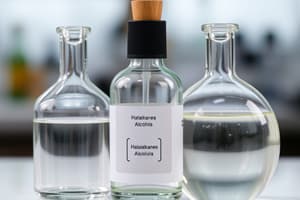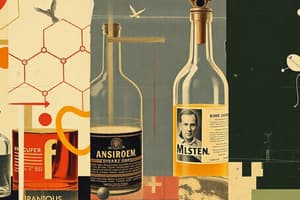Podcast
Questions and Answers
What is produced when alcohol reacts with phosphorus trichloride?
What is produced when alcohol reacts with phosphorus trichloride?
- Alkyl bromide
- Alkyl chloride (correct)
- Alkyl iodide
- Phosphonic acid
Which compound represents the byproduct of the reaction between an alcohol and PCl3?
Which compound represents the byproduct of the reaction between an alcohol and PCl3?
- Phosphine
- Hydrochloric acid
- Phosphoric acid
- Phosphorous acid (correct)
In the reaction 3R-OH + PCl3 → 3R-Cl + H3PO3, what does R represent?
In the reaction 3R-OH + PCl3 → 3R-Cl + H3PO3, what does R represent?
- An aromatic compound
- A functional group
- A halogen atom
- An alkyl group (correct)
What is the main purpose of reacting phosphorus trichloride with alcohols?
What is the main purpose of reacting phosphorus trichloride with alcohols?
Which of the following is an example of an alkyl halide produced from the reaction with PCl3 and alcohol?
Which of the following is an example of an alkyl halide produced from the reaction with PCl3 and alcohol?
What product is formed when Methyl Alcohol reacts with Phosphorus Trichloride?
What product is formed when Methyl Alcohol reacts with Phosphorus Trichloride?
Which reagent is commonly used in the reaction with Ethyl Alcohol to generate Ethyl Chloride?
Which reagent is commonly used in the reaction with Ethyl Alcohol to generate Ethyl Chloride?
What is the general principle illustrated in the reactions involving alcohols and chlorides?
What is the general principle illustrated in the reactions involving alcohols and chlorides?
Which of the following reagents acts similarly to a catalyst in the reactions of alcohols with chlorides?
Which of the following reagents acts similarly to a catalyst in the reactions of alcohols with chlorides?
What byproduct is associated with the reaction of alcohols using thionyl chloride?
What byproduct is associated with the reaction of alcohols using thionyl chloride?
What product is formed when ethyl alcohol reacts with thionyl chloride?
What product is formed when ethyl alcohol reacts with thionyl chloride?
How does a primary alcohol react with Lucas reagent?
How does a primary alcohol react with Lucas reagent?
Which type of alcohol reacts rapidly with Lucas reagent to form an alkyl halide?
Which type of alcohol reacts rapidly with Lucas reagent to form an alkyl halide?
What happens when methane is exposed to light in the presence of chlorine?
What happens when methane is exposed to light in the presence of chlorine?
What is the general behavior of secondary alcohols when reacting with Lucas reagent?
What is the general behavior of secondary alcohols when reacting with Lucas reagent?
What is the product formed when ethyl alcohol reacts with concentrated hydrogen chloride?
What is the product formed when ethyl alcohol reacts with concentrated hydrogen chloride?
What does a primary alcohol yield when reacted with Lucas reagent?
What does a primary alcohol yield when reacted with Lucas reagent?
Which of the following chloroalkanes is produced when methane undergoes chlorination?
Which of the following chloroalkanes is produced when methane undergoes chlorination?
During the chlorination of methane, which of the following substances is NOT a product?
During the chlorination of methane, which of the following substances is NOT a product?
Which product is formed from the reaction of ethyl alcohol with hydrogen chloride?
Which product is formed from the reaction of ethyl alcohol with hydrogen chloride?
What product is formed when a symmetrical alkene like ethene reacts with HCl?
What product is formed when a symmetrical alkene like ethene reacts with HCl?
According to Markovnikov's rule, when an unsymmetrical alkene reacts with HCl, where does the negative part of the HX attach?
According to Markovnikov's rule, when an unsymmetrical alkene reacts with HCl, where does the negative part of the HX attach?
What occurs when an unsymmetrical alkene reacts with HCl in the presence of peroxide?
What occurs when an unsymmetrical alkene reacts with HCl in the presence of peroxide?
In a halogen exchange reaction, what is the result of an alkyl halide reacting with sodium iodide?
In a halogen exchange reaction, what is the result of an alkyl halide reacting with sodium iodide?
What does the term 'Finkelstein reaction' specifically refer to?
What does the term 'Finkelstein reaction' specifically refer to?
What is formed when alkyl chlorides react with metallic fluorides?
What is formed when alkyl chlorides react with metallic fluorides?
What type of halide is characterized by the halogen atom being present at the allylic position?
What type of halide is characterized by the halogen atom being present at the allylic position?
Which of the following describes a halo arene?
Which of the following describes a halo arene?
Which of the following is an example of an aralkyl halide?
Which of the following is an example of an aralkyl halide?
In the reaction of methyl chloride with metallic fluorides, what is the byproduct produced?
In the reaction of methyl chloride with metallic fluorides, what is the byproduct produced?
Flashcards are hidden until you start studying
Study Notes
Preparation of Haloalkanes (Alkyl Halides) from Alcohols
- Alcohols react with Phosphorus Trichloride (PCl3) to produce alkyl chlorides and phosphorous acid.
- General Reaction: 3R-OH + PCl3 → 3R-Cl + H3PO3
- R represents an alkyl group
- 3R-OH represents an alcohol
- 3R-Cl represents an alkyl chloride
- H3PO3 is phosphorous acid
- Example: The reaction of 2-methylpropan-2-ol with PCl3 yields 2-chloro-2-methylpropane.
Chemical Reactions Involving Alcohols and Chlorides
- Alcohols react with phosphorus trichloride ($PCl_3$), phosphorus pentachloride ($PCl_5$), and thionyl chloride ($SOCl_2$) to form alkyl chlorides.
- Examples:
- Methyl Alcohol (CH₃OH) + Phosphorus Trichloride ($PCl_3$) → Methyl Chloride ($CH_3Cl$)
- Ethyl Alcohol ($C_2H_5OH$) + Phosphorus Pentachloride ($PCl_5$) → Ethyl Chloride ($C_2H_5Cl$)
- These reagents act as catalysts, replacing the hydroxyl group with a chlorine atom.
Chemical Reactions of Alcohols
- Reactions with Thionyl Chloride:
- Ethyl Alcohol (C₂H₅OH) + thionyl chloride (SOCl₂) → ethyl chloride (C₂H₅Cl)
- Reactions with Lucas Reagent:
- Primary alcohols don't react with Lucas reagent (concentrated HCl + Anhydrous ZnCl₂)
- Secondary alcohols react slowly with Lucas reagent to form secondary alkyl halides.
- Tertiary alcohols react rapidly with Lucas reagent to form tertiary alkyl halides.
- Reactions with Chlorine:
- Methane (CH₄) + chlorine (Cl₂) in the presence of light → chloromethane (CH₃Cl) and hydrogen chloride (HCl)
Reactions of Alcohols and Alkanes
- Reaction of Ethyl Alcohol with Hydrogen Chloride
- Ethyl alcohol (CH₃CH₂OH) + concentrated hydrogen chloride (HCl) → ethyl chloride (CH₃CH₂Cl) + water (H₂O).
- Lucas Reagent and Primary Alcohols
- Primary alcohol + Lucas Reagent → primary alkyl chloride
- Chlorination of Methane
- Methane (CH₄) + chlorine (Cl₂) in the presence of sunlight → various chloroalkanes
- Chloromethane (CH₃Cl)
- Dichloromethane (CH₂Cl₂)
- Trichloroethane (CHCl₃)
- Tetrachloromethane (CCl₄) (Carbon tetrachloride)
- Methane (CH₄) + chlorine (Cl₂) in the presence of sunlight → various chloroalkanes
Organic Chemistry Notes
- Alkene Reactions
- From Symmetrical Alkene:
- Symmetrical alkene (like ethene) + HCl → chloroethane
- From Unsymmetrical Alkene (Markovnikov's Rule):
- Unsymmetrical alkene + hydrogen halide (HX) → negative part of HX attaches to the carbon with fewer hydrogens.
- Anti-Markovnikov's Rule (Peroxide Effect/ Kharasch Effect):
- Unsymmetrical alkene + hydrogen halide (HX) + peroxide → negative part of HX attaches to the carbon with more hydrogens.
- From Symmetrical Alkene:
- Other Reactions
- Halogen Exchange Reaction: Alkyl chloride or bromide + sodium iodide in acetone → alkyl iodide.
- R-Cl + NaI → R-I + NaCl
- R-Br + NaI → R-I + NaBr
- Finkelstein Reaction: Similar to halogen exchange but using sodium iodide.
- Borodine Hunsdiecker Reaction: Silver salt of acids + bromine in the presence of silver → alkyl bromide.
- R-COO-Ag + Br2 → R-Br + AgBr + CO2
- Halogen Exchange Reaction: Alkyl chloride or bromide + sodium iodide in acetone → alkyl iodide.
- Reaction of Alkyl Halides with Metal Fluorides:
- Alkyl chloride or bromide + metal fluorides (AgF, Hg₂F₂, etc.) → alkyl fluoride.
- Example: CH₃-Cl + AgF → CH₃-F + AgCl (methyl chloride to methyl fluoride)
Halo Arenes
- Derivatives of aromatic hydrocarbons where hydrogen atoms are replaced with halogen groups.
Additional Notes
- Allylic Halide: The halogen atom is present at the allylic position.
- Example: 3-bromocyclohexane
- Aralkyl Halides: Halogen atoms are attached to an aromatic ring that is part of a longer carbon chain.
- Example: Benzyl halide
Studying That Suits You
Use AI to generate personalized quizzes and flashcards to suit your learning preferences.




